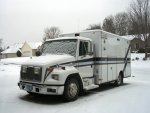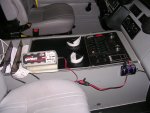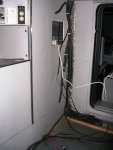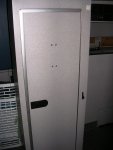You are using an out of date browser. It may not display this or other websites correctly.
You should upgrade or use an alternative browser.
You should upgrade or use an alternative browser.
Buying & Building a Medium Ambulance into an RV – The FAM-BULANCE
- Thread starter rlrenz
- Start date
rlrenz
Explorer
My Medic-Master/Freightliner came with 4 group 31 batteries, so they can still start the Cummins even if they are down a bit - the painful part is thinking about replacing 4 batteries at about $125 each. That's why I'm planning to upgrade my charging supply, probably by adding a 40-60 amp Xantrex 3-stage charger in place of the Vanner's 2-stage charger. I've thought about replacing the entire Vanner with a Xantrex combined charger-inverter, but right now, I'm leaning towards just adding a charger, and using a selector switch to set which charger does the charging. Theoretically, the medically-approved Vanner should be worth about $700 +/-, but the only one I've seen on EBay hasn't had any bids at all.
patoz
Expedition Leader
My Medic-Master/Freightliner came with 4 group 31 batteries, so they can still start the Cummins even if they are down a bit - the painful part is thinking about replacing 4 batteries at about $125 each. That's why I'm planning to upgrade my charging supply, probably by adding a 40-60 amp Xantrex 3-stage charger in place of the Vanner's 2-stage charger. I've thought about replacing the entire Vanner with a Xantrex combined charger-inverter, but right now, I'm leaning towards just adding a charger, and using a selector switch to set which charger does the charging. Theoretically, the medically-approved Vanner should be worth about $700 +/-, but the only one I've seen on EBay hasn't had any bids at all.
If you decide to sell your existing Vanner, let me know because right now I have nothing.
Like you, I'm on the fence about what to put in there. I know I will have at least one bank of two batteries located in the factory battery compartment, but undecided on whether they will be two 12VDC's in parallel, or two 6VDC's golf cart type in series, all deep cycle type since I will have no engine to start. And, since I will not have an engine alternator to charge them, my sources will be a 10 ga. 12VDC wire from the tow vehicle battery system, and the on-board charger via shore power and the on-board Honda generator. Solar panels are also on the list, but somewhere way down the road. If my 12V loads demand it, I may add a second battery bank similar to the first one. Finding space for all of this is something else...
rlrenz
Explorer
If you decide to sell your existing Vanner, let me know because right now I have nothing.
Like you, I'm on the fence about what to put in there. I know I will have at least one bank of two batteries located in the factory battery compartment, but undecided on whether they will be two 12VDC's in parallel, or two 6VDC's golf cart type in series, all deep cycle type since I will have no engine to start. And, since I will not have an engine alternator to charge them, my sources will be a 10 ga. 12VDC wire from the tow vehicle battery system, and the on-board charger via shore power and the on-board Honda generator. Solar panels are also on the list, but somewhere way down the road. If my 12V loads demand it, I may add a second battery bank similar to the first one. Finding space for all of this is something else...
I would not install a Vanner unless you need a medically approved inverter. The fact that they are rated for an ambulance makes them more expensive. I would look at a Xantrex inverter/charger. If you go that route, be sure that you wind up with a 3-stage charger (capable of battery maintenance). You might also take a look at the Xantrex Echo Charger - this will charge a second battery at up to 15 amps as long as your primary battery's coltage shows that it is being charged.
rlrenz
Explorer
There is a world of information out there, and a lot of it is available on the internet --- if we know what to look for. Gentlemen, I herewith present you with the GM Upfitter Best Practices Manual website (https://www.gmupfitter.com/pages/best-practice-manuals), This set of manuals is intended for specialty vehicle builders (eg: building an ambulance on a GM truck chassis), but the data is 95% applicable to any chassis out there. The electrical section in particular is impressive. Lots of good advice, and all for no charge.
Have fun!
Have fun!
patoz
Expedition Leader
I would not install a Vanner unless you need a medically approved inverter. The fact that they are rated for an ambulance makes them more expensive. I would look at a Xantrex inverter/charger. If you go that route, be sure that you wind up with a 3-stage charger (capable of battery maintenance). You might also take a look at the Xantrex Echo Charger - this will charge a second battery at up to 15 amps as long as your primary battery's coltage shows that it is being charged.
Not only am I getting old and creaky, I'm forgetting things too. I looked at the Xantrex before and that's the one I was thinking of. I like the idea of not having to buy dual battery charging capability unless I actually install a second battery or bank, just need to make sure I allow space for the upgrade if done.
patoz
Expedition Leader
There is a world of information out there, and a lot of it is available on the internet --- if we know what to look for. Gentlemen, I herewith present you with the GM Upfitter Best Practices Manual website (https://www.gmupfitter.com/pages/best-practice-manuals), This set of manuals is intended for specialty vehicle builders (eg: building an ambulance on a GM truck chassis), but the data is 95% applicable to any chassis out there. The electrical section in particular is impressive. Lots of good advice, and all for no charge.
Have fun!
Ford has a similar website , but it's a lot harder to find stuff on it. It only goes back to about 1997, the older manuals are in book form, and must be ordered. First copy is free. Unfortunately, a lot of us have early 90's model ambulances and there are no manuals available.
rlrenz
Explorer
Manuals for ambulances are nearly impossible to track down. If you have anything older, forgeddaboutit (sp??) - it ain't gonna happen. If you have something newer, maybe less than 10 years old, there is a change of getting the builder to make you a new manual. I've been looking for a manual for my 1999 Medic-master since I bought it, and I haven't managed to sniff one out yet, even with a standing offer of $200 as a purchase price offer. Generally, every builder should do things their own way, but there should be some consistency between models and years -- wire numbers should be fairly constant, wire routing should stay about the same, things should be installed in about the same places, etc. Also, if you have an ambulance built before about 2001 +/- (before the digital-everything move took place), you probably have separate relays, switches, and diodes doing the job. Many ambulances had relay panels built by Wired-Rite, since their panels can be set up for positive (eg: signal from another relay) or negative (eg: a door switch) control signals. Their panels have LED pilot lights, so you can flip switches or open doors and see which lights come on.
If you have a digital-everything ambulance, you may / may not have luck tracking down data. If the builder has gone through multiple suppliers, lottsa luck, but I've seen quite a few controls from Akron Brass out there. If you have a digital system, take a look at the Akron Brass web site, and check out the V-MUX section of their electronics products page. Some builders have gone through multiple iterations, and data / parts on their older equipment may be very scarce. Sometimes, you may be able to track down used components from a ambulance company that does re-mounts.
Generally, access to ambulance wiring is through light fixture openings or emergency light (outside) openings. Since the wires and cables are run through split convoluted tubing, you can look to see what color wires are in there, plus they are labeled every few inches with what they are for.
Ambulance manuals are mostly generic as well - they contain material from the vehicle manufacturer - in my case, Freightliner, and it would include the maintenance manual, the driver's manual, and an operation & maintenance manual for the engine (I was able to track down copies on E BAY), and it would have included ambulance material, but a lot of the ambulance material is generic to that manufacturer --- data on the stretcher, data on the oxygen system, data on the seats, data on the 2-way radios, etc. There is actually only a limited amount of data specific to a particular ambulance. Even so, a manual is very nice to have since it is more knowledge about something we don't know much about, but it isn't crucial.
And that being said, I still have a standing offer of $200 for a Freightliner / Medic-Master manual from somewhere between 1998-2001
If you have a digital-everything ambulance, you may / may not have luck tracking down data. If the builder has gone through multiple suppliers, lottsa luck, but I've seen quite a few controls from Akron Brass out there. If you have a digital system, take a look at the Akron Brass web site, and check out the V-MUX section of their electronics products page. Some builders have gone through multiple iterations, and data / parts on their older equipment may be very scarce. Sometimes, you may be able to track down used components from a ambulance company that does re-mounts.
Generally, access to ambulance wiring is through light fixture openings or emergency light (outside) openings. Since the wires and cables are run through split convoluted tubing, you can look to see what color wires are in there, plus they are labeled every few inches with what they are for.
Ambulance manuals are mostly generic as well - they contain material from the vehicle manufacturer - in my case, Freightliner, and it would include the maintenance manual, the driver's manual, and an operation & maintenance manual for the engine (I was able to track down copies on E BAY), and it would have included ambulance material, but a lot of the ambulance material is generic to that manufacturer --- data on the stretcher, data on the oxygen system, data on the seats, data on the 2-way radios, etc. There is actually only a limited amount of data specific to a particular ambulance. Even so, a manual is very nice to have since it is more knowledge about something we don't know much about, but it isn't crucial.
And that being said, I still have a standing offer of $200 for a Freightliner / Medic-Master manual from somewhere between 1998-2001
Last edited:
rlrenz
Explorer
This is a thoroughly soggy day. It's been colder than usual here, and many projects are caught in the never-never land between fall and winter. The ambulance hasn't made it into the garage yet - I can probably get half of it into the garage. Sorting and cleaning continue...

In other news, I got my NOCO battery charger set up today. Happily, I have one 12 volt receptacle that is connected directly to the battery, so I could set up the charger, and plug it in. The NOCO manual states that the charger can maintain any sized battery -- we'll see. As long as the LED display says charged, I'm going to be happy. I have it positioned on top of the console so I can easily see it from the outside. As long as the 100% charged LED stays green, it's all A-OK.

In still other news, it thawed today, and the sudden warm weather meant cloudy and foggy, but I had already decided to remove the beast's radio cabinet. The cabinet will be reworked into a power cabinet for the 120, and also for the new air conditioning controls. All the cabinets are "just" screwed into place, and some sealing gook is applied to all the seams where the cabinets connect to each other. That sealing gook seems to be made from epoxy mixed with diamond dust, because it killed my utility knife blades one after the other, but I finally got the seams cut. Then, I used a thinned Wonder bar to get things wiggling, and I was finally able to get the cabinet loose and out.
Where the radio cabinet was - I now have direct access to the main wiring cableways.

The radio cabinet - it will now go downstairs to my workshop so I can install the Blue Sea equipment more easily than standing on my head in the module


In other news, I got my NOCO battery charger set up today. Happily, I have one 12 volt receptacle that is connected directly to the battery, so I could set up the charger, and plug it in. The NOCO manual states that the charger can maintain any sized battery -- we'll see. As long as the LED display says charged, I'm going to be happy. I have it positioned on top of the console so I can easily see it from the outside. As long as the 100% charged LED stays green, it's all A-OK.

In still other news, it thawed today, and the sudden warm weather meant cloudy and foggy, but I had already decided to remove the beast's radio cabinet. The cabinet will be reworked into a power cabinet for the 120, and also for the new air conditioning controls. All the cabinets are "just" screwed into place, and some sealing gook is applied to all the seams where the cabinets connect to each other. That sealing gook seems to be made from epoxy mixed with diamond dust, because it killed my utility knife blades one after the other, but I finally got the seams cut. Then, I used a thinned Wonder bar to get things wiggling, and I was finally able to get the cabinet loose and out.
Where the radio cabinet was - I now have direct access to the main wiring cableways.

The radio cabinet - it will now go downstairs to my workshop so I can install the Blue Sea equipment more easily than standing on my head in the module

sarconcepts
Adventurer
That's a great charger, good choice
I have the same one & feel totally comfortable leaving it on, unattended, for weeks at a time.
(& yes, it will handle any battery)
I have the same one & feel totally comfortable leaving it on, unattended, for weeks at a time.
(& yes, it will handle any battery)
rlrenz
Explorer
My friendly neighborhood ambulance electrician had recommended the NOCO as being a darn decent charger, and I like it. It is solidly built, well packaged, and does the job very well. My ONLY beef is that the manual was printed by someone who felt that paper was a luxury if it came in sized larger than about 4" square or so - but not a problem - the manual is on line, and my new printed copy is MUCH larger than 4" x 4. You may have noticed that it is propped up at a convenient angle - that's through a chunk of 3" aluminum channel. That way, I can take a peek through the side window and make sure that the green "happy battery light" is on. I also have a solar version that will live on the dashboard in the summer.
Next spring, I'm installing a Xantrex battery charger, and I'm torn between using a 60 amp charger, or installing two paralleled 40 amp chargers--- a pair of 40's would definitely keep ahead of the lights/etc while the beast is plugged in to shore power (campground, for example). For now, I'm concentrating on getting the old radio cabinet turned into a 120 volt breaker center (but I will make provisions for two chargers in the 120 VAC wiring)
Next spring, I'm installing a Xantrex battery charger, and I'm torn between using a 60 amp charger, or installing two paralleled 40 amp chargers--- a pair of 40's would definitely keep ahead of the lights/etc while the beast is plugged in to shore power (campground, for example). For now, I'm concentrating on getting the old radio cabinet turned into a 120 volt breaker center (but I will make provisions for two chargers in the 120 VAC wiring)
patoz
Expedition Leader
My friendly neighborhood ambulance electrician had recommended the NOCO as being a darn decent charger, and I like it. It is solidly built, well packaged, and does the job very well. My ONLY beef is that the manual was printed by someone who felt that paper was a luxury if it came in sized larger than about 4" square or so - but not a problem - the manual is on line, and my new printed copy is MUCH larger than 4" x 4. You may have noticed that it is propped up at a convenient angle - that's through a chunk of 3" aluminum channel. That way, I can take a peek through the side window and make sure that the green "happy battery light" is on. I also have a solar version that will live on the dashboard in the summer.
Next spring, I'm installing a Xantrex battery charger, and I'm torn between using a 60 amp charger, or installing two paralleled 40 amp chargers--- a pair of 40's would definitely keep ahead of the lights/etc while the beast is plugged in to shore power (campground, for example). For now, I'm concentrating on getting the old radio cabinet turned into a 120 volt breaker center (but I will make provisions for two chargers in the 120 VAC wiring)
I put the NOCO charger on my Amazon Wish List for my next order from them. I may get a couple of them because I also need one for an SUV that I don't drive very often. However, I already have two of the older (2003) Marinco 'Guest', dual battery, 10 amp chargers that I used when I had my pontoon boat. They both still work fine, so I thought I might start out with one of them temporary, especially if I use a two battery system. It would probably keep up with LED interior lights and a 12VDC stereo system, but not sure what else.
That is a nice looking rig BTW, it looks almost brand new!
rlrenz
Explorer
I'm very impressed with the NOCO charger - I'll definitely keep it as a garage charger once I get the new Xantrex chargers installed and I'll get rid of my old Dayton 6-12-24 V charger. A LED doesn't pull a lot of power, and neither does a stereo (unless you are into very heavy rock music-the kind that will sterilize a gerbil at 50 ft) - the GOTTCHA might be what else is on that is overlooked, like door-switch operated lights, or an exhaust fan. Regardless, give it a try and see what happens. One trick to remember is that many digital multimeters (like Fluke) have an internal 10 amp ammeter that's both AC & DC, so it might be possible to run the charger's output through the meter to see where you are.
Yes, it is nice looking. I like the styling, which was actually a selling point when I looked at the cost of repainting a color scheme I couldn't stand - kind of like looking at a house-for-sale with lime green shag carpeting. All you'll see is the carpet, and no matter how nice the house is, the carpet will always be first in your memory.
Other than the styling and paint, I really went for the mileage (51,000), the engine (Cummins 5.9), the vehicle overall condition, and my feelings about the dealer. The rig was reconditioned when I got it, which meant inspected, repaired, and all the fluids changed. I had a new alternator, 2 new front tires, new air compressor, new AC compressor, new suction pump, repainting of some oxidized aluminum, clear lenses in place of the colored lenses (required by PA) and a new Vanner inverter/charger. I later had problems with a failed brake line, but it needed a mirror and flashlight to even see, so I can't fault the dealer for that. I wanted to be able to convert it to an RV fairly easily, so the cabinet (interior and exterior) configuration was also important.
Yes, it is nice looking. I like the styling, which was actually a selling point when I looked at the cost of repainting a color scheme I couldn't stand - kind of like looking at a house-for-sale with lime green shag carpeting. All you'll see is the carpet, and no matter how nice the house is, the carpet will always be first in your memory.
Other than the styling and paint, I really went for the mileage (51,000), the engine (Cummins 5.9), the vehicle overall condition, and my feelings about the dealer. The rig was reconditioned when I got it, which meant inspected, repaired, and all the fluids changed. I had a new alternator, 2 new front tires, new air compressor, new AC compressor, new suction pump, repainting of some oxidized aluminum, clear lenses in place of the colored lenses (required by PA) and a new Vanner inverter/charger. I later had problems with a failed brake line, but it needed a mirror and flashlight to even see, so I can't fault the dealer for that. I wanted to be able to convert it to an RV fairly easily, so the cabinet (interior and exterior) configuration was also important.
Similar threads
- Replies
- 1
- Views
- 700
- Replies
- 0
- Views
- 386
- Replies
- 3
- Views
- 1K
- Replies
- 1
- Views
- 755
